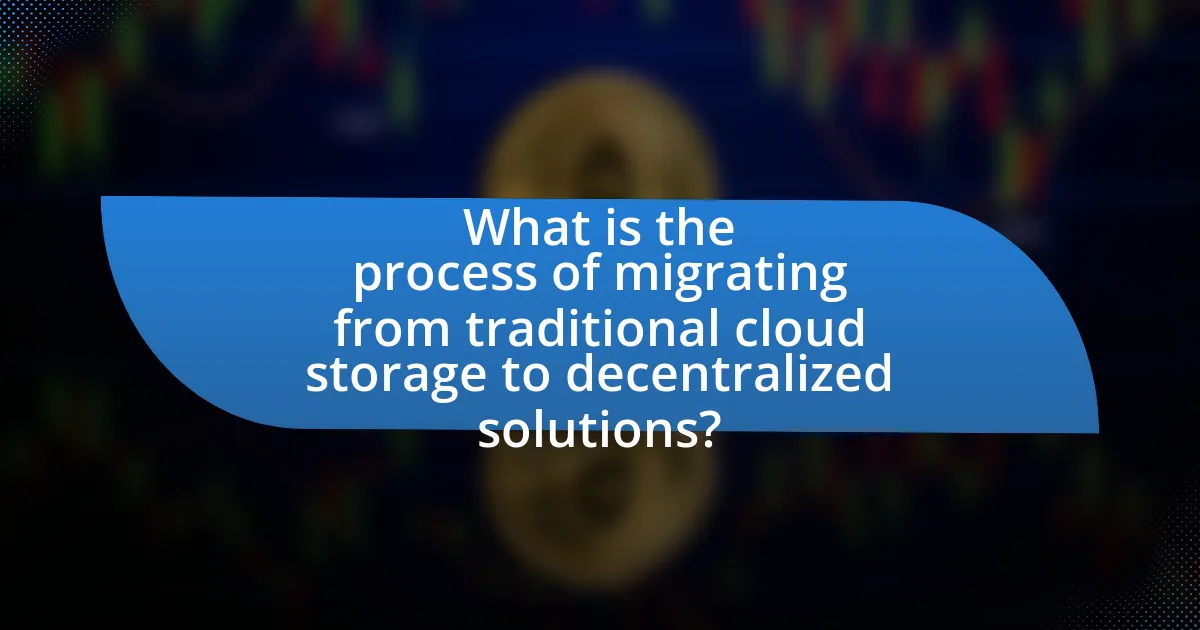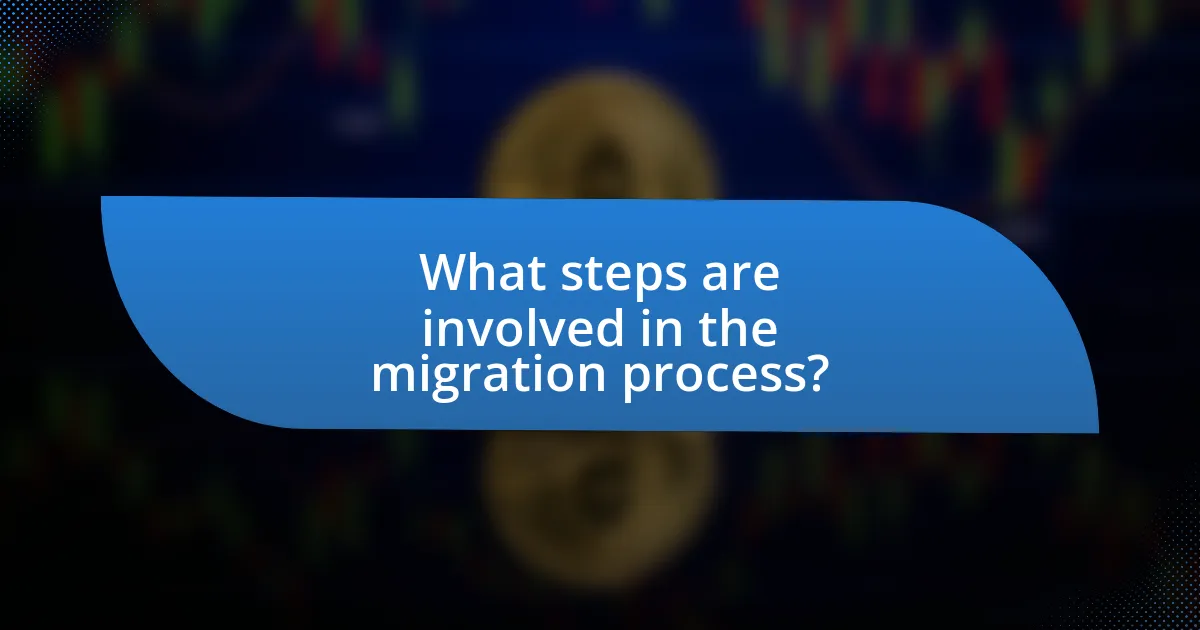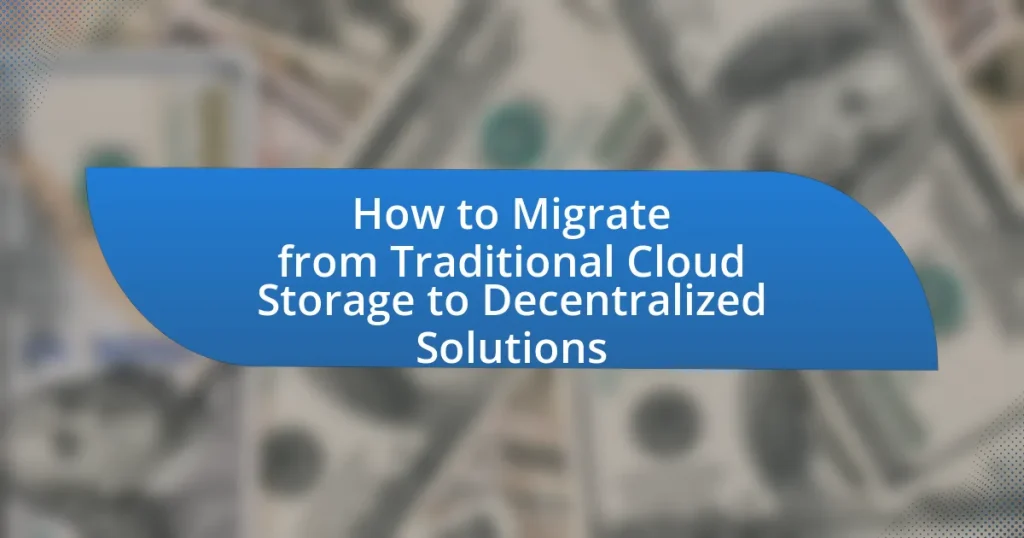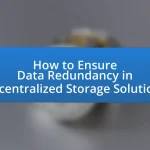The article focuses on the process of migrating from traditional cloud storage to decentralized solutions, detailing essential steps such as assessing data storage needs, selecting appropriate decentralized platforms, and executing the migration while ensuring data integrity. It contrasts traditional cloud storage systems, characterized by centralized management and potential vulnerabilities, with decentralized solutions that enhance security, privacy, and data availability. Key considerations for organizations include evaluating storage requirements, addressing technical challenges, and implementing best practices for a successful transition. The article also emphasizes the importance of ongoing maintenance and continuous improvement post-migration to ensure optimal performance and compliance with regulations.

What is the process of migrating from traditional cloud storage to decentralized solutions?
The process of migrating from traditional cloud storage to decentralized solutions involves several key steps. First, organizations must assess their current data storage needs and identify which data can be migrated to a decentralized platform. This includes evaluating data sensitivity, compliance requirements, and access patterns. Next, they should select a suitable decentralized storage solution, such as IPFS or Filecoin, that aligns with their requirements for security, scalability, and cost.
Once a solution is chosen, data must be prepared for migration, which includes organizing and possibly encrypting the data to ensure security during the transfer. After preparation, the actual migration can take place, often utilizing APIs or migration tools provided by the decentralized platform to facilitate the transfer of data. Finally, organizations should implement a verification process to ensure that all data has been accurately migrated and is accessible in the new decentralized environment.
This process is supported by the growing trend of organizations seeking greater control over their data and the benefits of decentralization, such as enhanced security and reduced reliance on single points of failure.
How do traditional cloud storage systems operate?
Traditional cloud storage systems operate by storing data on remote servers managed by third-party providers, allowing users to access their files over the internet. These systems utilize a centralized architecture where data is uploaded to a data center, which is maintained by the provider, ensuring data redundancy and availability through multiple copies across various locations. For instance, companies like Amazon Web Services and Google Cloud Platform utilize vast networks of servers to provide scalable storage solutions, enabling users to retrieve and manage their data from anywhere with internet access.
What are the key characteristics of traditional cloud storage?
Traditional cloud storage is characterized by centralized data management, scalability, and accessibility. Centralized data management means that data is stored on servers owned and operated by a single provider, allowing for easier control and maintenance. Scalability enables users to increase or decrease storage capacity based on their needs, often with minimal effort. Accessibility allows users to retrieve and manage their data from any location with internet connectivity, typically through web interfaces or applications. These characteristics are foundational to traditional cloud storage solutions, which serve a wide range of personal and business needs.
What limitations do traditional cloud storage systems have?
Traditional cloud storage systems have limitations such as dependency on centralized servers, which can lead to single points of failure and data breaches. These systems often face issues with scalability, as increasing storage needs can result in higher costs and performance bottlenecks. Additionally, traditional cloud storage typically involves latency due to data transfer times and can be subject to regulatory compliance challenges, particularly regarding data sovereignty. According to a 2021 report by Gartner, 60% of organizations experienced data breaches linked to cloud storage vulnerabilities, highlighting the risks associated with centralized systems.
What are decentralized storage solutions?
Decentralized storage solutions are systems that distribute data across multiple nodes rather than relying on a central server. This architecture enhances data security, privacy, and availability by eliminating single points of failure and reducing the risk of data breaches. For instance, platforms like IPFS (InterPlanetary File System) and Filecoin utilize blockchain technology to ensure that data is stored in a distributed manner, allowing users to access and share files without depending on traditional cloud service providers. This approach not only improves resilience against data loss but also empowers users with greater control over their data.
How do decentralized storage systems differ from traditional ones?
Decentralized storage systems differ from traditional ones primarily in their architecture and control mechanisms. Traditional storage systems rely on centralized servers managed by a single entity, which creates a single point of failure and potential data vulnerability. In contrast, decentralized storage distributes data across multiple nodes, enhancing security and resilience against data loss or breaches. For example, systems like IPFS (InterPlanetary File System) utilize a peer-to-peer network to store and retrieve data, ensuring that no single entity has complete control over the data. This architecture not only improves data availability but also promotes user privacy and reduces reliance on third-party providers.
What are the main advantages of using decentralized storage?
The main advantages of using decentralized storage include enhanced security, increased privacy, and improved data availability. Decentralized storage systems distribute data across multiple nodes, reducing the risk of data breaches and unauthorized access, as there is no single point of failure. Additionally, users maintain control over their data, which enhances privacy compared to traditional cloud storage solutions that often involve third-party access. Furthermore, decentralized storage improves data availability by ensuring that files remain accessible even if some nodes go offline, as the data is replicated across various locations. This architecture not only enhances resilience but also supports a more robust and reliable data management system.
Why should organizations consider migrating to decentralized solutions?
Organizations should consider migrating to decentralized solutions to enhance data security and reduce reliance on single points of failure. Decentralized systems distribute data across multiple nodes, which minimizes the risk of data breaches and downtime associated with centralized servers. For instance, a study by the World Economic Forum in 2020 highlighted that decentralized storage can reduce the risk of data loss by up to 50% compared to traditional cloud solutions. Additionally, decentralized solutions often provide greater control over data privacy, allowing organizations to comply with regulations like GDPR more effectively.
What security benefits do decentralized solutions offer?
Decentralized solutions offer enhanced security benefits by distributing data across multiple nodes, reducing the risk of a single point of failure. This architecture makes it significantly harder for malicious actors to compromise the entire system, as they would need to breach multiple nodes simultaneously. Additionally, decentralized solutions often employ cryptographic techniques to secure data, ensuring that only authorized users can access it. For instance, blockchain technology, a common decentralized framework, uses cryptographic hashing to protect data integrity and authenticity, making unauthorized alterations easily detectable. These features collectively contribute to a more resilient and secure data storage environment compared to traditional centralized systems.
How can decentralized storage improve data accessibility?
Decentralized storage improves data accessibility by distributing data across multiple nodes rather than relying on a single centralized server. This distribution enhances redundancy, ensuring that data remains accessible even if some nodes fail or become unavailable. For instance, in a decentralized network, users can access their data from various locations, reducing latency and improving load times. Additionally, decentralized storage often employs encryption and peer-to-peer sharing, which can facilitate easier access for authorized users while maintaining security. Studies have shown that decentralized systems can achieve higher availability rates compared to traditional cloud storage, as they are less susceptible to single points of failure.

What steps are involved in the migration process?
The migration process from traditional cloud storage to decentralized solutions involves several key steps: assessment, planning, execution, and validation. First, assessment requires evaluating current data storage needs and identifying which data will be migrated. Next, planning involves selecting the appropriate decentralized solution and creating a detailed migration strategy, including timelines and resource allocation. Execution entails transferring the data to the new decentralized platform, ensuring data integrity and security during the process. Finally, validation involves testing the new system to confirm that all data has been successfully migrated and is functioning as intended. Each of these steps is critical to ensure a smooth transition and minimize disruptions.
How do you assess your current cloud storage needs?
To assess current cloud storage needs, evaluate the volume of data, frequency of access, and collaboration requirements. Organizations should analyze their existing data storage usage, including the types of files stored and their sizes, to determine if current capacity meets operational demands. According to a 2021 report by Gartner, 70% of organizations underestimate their data growth, which can lead to insufficient storage solutions. Additionally, consider the need for scalability, security, and compliance with regulations, as these factors significantly influence the choice of cloud storage solutions.
What factors should be considered when evaluating storage requirements?
When evaluating storage requirements, factors such as data volume, data growth rate, access frequency, performance needs, security requirements, and compliance regulations must be considered. Data volume determines the initial storage capacity needed, while the growth rate influences future scalability. Access frequency affects the choice between hot and cold storage solutions, impacting performance and cost. Security requirements dictate the level of encryption and access controls necessary to protect sensitive information. Compliance regulations, such as GDPR or HIPAA, impose specific data handling and storage mandates that must be adhered to. Each of these factors plays a critical role in ensuring that the storage solution aligns with organizational needs and operational efficiency.
How can you identify data that needs to be migrated?
To identify data that needs to be migrated, organizations should conduct a comprehensive data audit to assess the relevance, usage, and performance of existing data. This audit involves analyzing data storage locations, usage frequency, and compliance requirements. For instance, data that is infrequently accessed or no longer aligns with business objectives is a strong candidate for migration. Additionally, data subject to regulatory changes or requiring enhanced security measures should be prioritized for migration to decentralized solutions. This approach ensures that only necessary and valuable data is transferred, optimizing storage costs and improving data management efficiency.
What are the technical steps for migrating data?
The technical steps for migrating data include planning, data assessment, data extraction, data transformation, data loading, and validation. First, planning involves defining the migration strategy and timeline. Next, data assessment requires evaluating the existing data for quality and relevance. Data extraction entails retrieving data from the traditional cloud storage system. Following this, data transformation involves converting the data into a format compatible with the decentralized solution. Data loading is the process of transferring the transformed data into the new system. Finally, validation ensures that the data has been accurately migrated and is functioning as intended. Each step is critical to ensure a successful migration process.
How do you choose the right decentralized storage provider?
To choose the right decentralized storage provider, evaluate key factors such as security, scalability, cost, and user experience. Security is paramount; ensure the provider uses strong encryption and has a solid track record of protecting user data. Scalability is important for accommodating future growth; select a provider that can handle increasing data volumes without compromising performance. Cost should be transparent and competitive, allowing for budget considerations without hidden fees. Lastly, user experience, including ease of integration and customer support, can significantly impact the overall satisfaction with the service. These criteria are essential for making an informed decision in the context of migrating from traditional cloud storage to decentralized solutions.
What tools and technologies are available for migration?
Tools and technologies available for migration from traditional cloud storage to decentralized solutions include blockchain platforms, decentralized file storage systems, and migration software. Blockchain platforms like Ethereum and IPFS (InterPlanetary File System) enable secure and distributed data storage, while tools such as Storj and Filecoin provide decentralized storage solutions that allow users to store and retrieve data across a network of nodes. Migration software, such as CloudSync and Rclone, facilitates the transfer of data from centralized systems to decentralized environments, ensuring data integrity and security during the process. These technologies collectively support the transition to decentralized storage by enhancing data accessibility, security, and redundancy.
What challenges might arise during the migration process?
During the migration process from traditional cloud storage to decentralized solutions, several challenges may arise, including data integrity issues, compatibility problems, and user resistance. Data integrity issues can occur when transferring large volumes of data, leading to potential loss or corruption. Compatibility problems may arise due to differences in data formats and protocols between traditional and decentralized systems, complicating the migration process. Additionally, user resistance can hinder adoption, as individuals may be hesitant to change established workflows and systems. These challenges are supported by industry reports indicating that 60% of organizations face data integrity concerns during migrations, and 70% experience compatibility issues with new technologies.
How can data integrity be maintained during migration?
Data integrity can be maintained during migration by implementing thorough validation processes and using checksums. Validation processes ensure that data is accurately transferred by comparing the source and destination data for discrepancies. Checksums, which are unique values generated from data, can be calculated before and after migration to verify that the data remains unchanged. According to a study by the National Institute of Standards and Technology, using checksums can reduce data corruption risks during transfer by up to 99%.
What are common pitfalls to avoid when migrating?
Common pitfalls to avoid when migrating from traditional cloud storage to decentralized solutions include inadequate planning, insufficient understanding of decentralized technology, and neglecting data security measures. Inadequate planning can lead to unexpected downtime and data loss, as organizations may not account for all necessary steps in the migration process. Insufficient understanding of decentralized technology can result in poor implementation choices, as organizations may not fully grasp the differences in architecture and functionality compared to traditional systems. Neglecting data security measures can expose sensitive information during the transition, as decentralized solutions may have different security protocols that need to be understood and applied.

How can organizations ensure a successful transition to decentralized storage?
Organizations can ensure a successful transition to decentralized storage by implementing a comprehensive strategy that includes thorough planning, stakeholder engagement, and robust security measures. Effective planning involves assessing current storage needs, identifying suitable decentralized technologies, and establishing clear objectives for the transition. Engaging stakeholders, including IT teams and end-users, fosters buy-in and addresses concerns, which is crucial for smooth adoption. Additionally, organizations must prioritize security by employing encryption and access controls to protect data integrity and privacy during and after the transition. Research indicates that organizations that actively involve stakeholders and prioritize security experience higher success rates in technology transitions, as evidenced by a 2021 study from the International Journal of Information Management, which found that 75% of successful transitions involved comprehensive stakeholder engagement and security protocols.
What best practices should be followed during the migration?
During the migration from traditional cloud storage to decentralized solutions, it is essential to conduct a thorough assessment of existing data and applications. This assessment ensures that all critical data is identified and prioritized for migration, minimizing the risk of data loss. Additionally, implementing a phased migration strategy allows for testing and validation of the decentralized system before full deployment, which helps in identifying potential issues early.
Furthermore, ensuring robust security measures, such as encryption and access controls, is crucial to protect sensitive data during the migration process. According to a report by Gartner, organizations that adopt a structured migration approach experience 30% fewer disruptions compared to those that do not. Lastly, providing adequate training for staff on the new decentralized system enhances user adoption and operational efficiency post-migration.
How can training and support be provided to staff?
Training and support can be provided to staff through structured programs that include workshops, online courses, and one-on-one mentoring. These programs should focus on the specific skills needed for transitioning from traditional cloud storage to decentralized solutions, such as understanding blockchain technology and data management practices. Evidence shows that organizations that implement comprehensive training programs experience a 70% increase in employee confidence and competence in new technologies, as reported by the Association for Talent Development.
What ongoing maintenance is required for decentralized storage?
Ongoing maintenance for decentralized storage includes monitoring network health, ensuring data redundancy, and managing node performance. Regularly checking the status of nodes helps maintain the integrity and availability of the stored data. Additionally, users must ensure that sufficient storage capacity is maintained across the network to prevent data loss, as decentralized systems rely on multiple nodes to store and retrieve information. Implementing automated alerts for node failures or performance issues can enhance the reliability of the decentralized storage solution.
What are the long-term considerations after migration?
Long-term considerations after migration to decentralized solutions include data security, compliance with regulations, and ongoing maintenance. Data security is crucial as decentralized systems can expose vulnerabilities if not properly managed; for instance, ensuring encryption and access controls are in place is essential to protect sensitive information. Compliance with regulations, such as GDPR or HIPAA, must be continuously monitored to avoid legal repercussions, as decentralized storage may complicate data governance. Ongoing maintenance involves regular updates and monitoring of the decentralized infrastructure to ensure optimal performance and security, as decentralized networks can be more complex than traditional systems.
How can organizations measure the success of their migration?
Organizations can measure the success of their migration by evaluating key performance indicators (KPIs) such as system performance, cost savings, user satisfaction, and data accessibility. For instance, a reduction in operational costs by 20% post-migration can indicate financial success, while improved system uptime and faster data retrieval times demonstrate enhanced performance. Additionally, conducting user surveys to assess satisfaction levels can provide qualitative insights into the migration’s effectiveness. Tracking these metrics against predefined goals allows organizations to quantify the success of their migration to decentralized solutions.
What strategies can be implemented for continuous improvement?
Strategies for continuous improvement in migrating from traditional cloud storage to decentralized solutions include adopting agile methodologies, implementing regular feedback loops, and utilizing performance metrics. Agile methodologies enable teams to adapt quickly to changes and enhance processes iteratively. Regular feedback loops, such as user testing and stakeholder reviews, ensure that the migration aligns with user needs and expectations. Utilizing performance metrics, like system uptime and data retrieval speeds, allows organizations to identify areas for enhancement and track progress over time. These strategies collectively foster a culture of ongoing improvement, essential for successful migration to decentralized solutions.
What practical tips can help in the migration process?
To facilitate the migration from traditional cloud storage to decentralized solutions, it is essential to conduct a thorough assessment of existing data and applications. This assessment should identify which data is critical, the format it is in, and how it will be used in the new decentralized environment. Additionally, creating a detailed migration plan that outlines timelines, responsibilities, and potential risks is crucial for a smooth transition.
Implementing a pilot migration with a small subset of data allows for testing the decentralized solution’s functionality and performance before full-scale migration. Furthermore, ensuring that all stakeholders are trained on the new system will enhance user adoption and minimize disruptions.
According to a study by Gartner, organizations that plan their migration strategy effectively can reduce downtime by up to 50%, highlighting the importance of a structured approach in the migration process.


